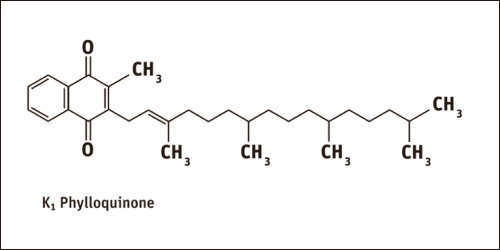Vitamin K
Phylloquinone | Menaquinones
Year of discovery: 1929 | Henrik Carl Peter Dam
Vitamin K plays a key role primarily in the process of blood clotting, by which its presence can determine life or death. More than ten different proteins and calcium in mineral form are involved in blood clot formation. Vitamin K is essential for the activation of several of these proteins. When any of these factors are missing during blood clotting, hemorrhagic disease (uncontrolled bleeding) occurs. Vitamin K is also involved in the metabolism of bone proteins, primarily osteocalcin. Without vitamin K, osteocalcin cannot bind to the elements that normally form bones, resulting in poor bone mineralization. Vitamin K is stored in the liver.
Main sources of vitamin K
Vitamin K is found in plant foods as phylloquinone (K1). Bacteria in the large intestine can synthesize vitamin K in the form of menaquinone (K2), which is absorbed by the body. Sources of phylloquinone include green leafy vegetables (i.e. parsley, spinach, brassicas and lettuce), cabbage and vegetable oils (soybean, canola, olive oil). Menaquinones are also found in fermented foods such as fermented cheese, cottage cheese and natto (fermented soybeans).
Bioavailability of vitamin K
The absorption of vitamin K from food is about 20%, and fat in the diet increases absorption.
Risks associated with insufficient or excessive intake of vitamin K
Vitamin K is poorly transferred across the placenta and is not found in significant amounts in breast milk, so newborns are particularly vulnerable to hemorrhage. This congenital vitamin K deficiency is treated by intramuscular injection or oral administration of phylloquinone. Vitamin K supplementation has been found to favorably increase bone density in adults with osteoporosis because it promotes the synthesis of a special protein called matrix protein Gla.




